FALL/WINTER 2024
A publication to inform and educate about the importance of protecting our lakes, streams, wetlands, and groundwater.


FALL/WINTER 2024
A publication to inform and educate about the importance of protecting our lakes, streams, wetlands, and groundwater.

CELEBRATING 45 YEARS AT THE WATERSHED COUNCIL
WATERSHED COUNCIL STAFF
Heather Huffstutler
EXECUTIVE DIRECTOR
Kory Alaniz
OPERATIONS SPECIALIST
Eli Baker
EDUCATION MANAGER
Calla Beers
WATER RESOURCES & COMMUNICATIONS SPECIALIST
Lauren Dey
ASSOCIATE DIRECTOR
Andrea Coronado COMMUNICATIONS & DEVELOPMENT DIRECTOR
Marcella Domka
WATER RESOURCES MANAGER
Michele Howard FINANCE DIRECTOR
Noah Jansen
RESTORATION MANAGER
Emily Johnson
WATER RESOURCES SPECIALIST
Natalie Walts OPERATIONS MANAGER
Anna Watson MONITORING COORDINATOR
WATERSHED COUNCIL BOARD OF DIRECTORS
Tom Darnton
PRESIDENT
Mike Hayes
VICE PRESIDENT
Scott Davis TREASURER
Perry Irish Hodgson SECRETARY
Linda Adams
John Gannon
Brian Hayes
Jerry Huey
Chuck Kneese
Bob Kingon
Ana Schwab
Karie Slavik
Mike Supernault
Greg Walz
Amanda Weinert
GET IN TOUCH
426 Bay St, Petoskey, MI 49770
Monday - Friday 8:30 a.m.- 5 p.m. (231) 347-1181
info@watershedcouncil.org watershedcouncil.org
MEMBERS OF:



Dear Friends,
Fall has arrived here in Northern Michigan. As cooler temperatures settle in, life naturally slows—both for wildlife and for us. Our tourist towns become quieter, cottagers close their seasonal homes, and the pace of daily life shifts. Yet, while it may seem like we slow down, behind the scenes we are as active as ever, ensuring fish habitats stay resilient as waters cool and preparing for a new season of fieldwork with partners, volunteers, and experts.
These quieter seasons offer time for reflection and renewal—something not just reserved for spring. In fact, autumn provides a perfect moment to pause, reconnect with nature, and recharge. Here are a few ways this season invites renewal:
Exploring connections: Walking along the shores of Duncan Bay in Cheboygan, I watch freighters carrying cargo and birds on their migratory journeys. It’s a reminder of the important ties between our work to expand public access along the Cheboygan River and the economic currents that flow through the Great Lakes.
Grounding in nature: The changing colors of the maple trees in my backyard reflect how well I’ve connected with the outdoors over the summer—whether my feet touched sand, water, or soil. As the sun shifts in late August, I embrace the chance for one last swim, a lingering walk, or a good book on the porch, knowing these moments carry me through the long winter ahead.
Recognizing the flow of water: Water's perpetual motion inspires us all, whether we’re consciously aware of it or not. Its presence is a constant reminder of its essential role in sustaining life.
This fall, we also take time to celebrate our recent achievements—many of which you’ll find in the following pages—and prepare for exciting opportunities ahead. Soon, we’ll share ways you can join us in closing out our 45th year stronger than ever. Looking toward 2025, we’re gearing up to launch a new strategic plan and explore new approaches to our conservation work. Your continued support makes all of this possible, and I can’t wait to show you what’s in store.

Heather Huffstutler
Heather Huffstutler Executive Director
A MESSAGE FROM THE BOARD PRESIDENT
Including Tip of the Mitt Watershed Council in your estate plan—known as “planned giving”—is one of the most impactful ways to support the future of our waters. While the size of the gift may be known, the exact timing is not. What is certain, however, is that whenever these gifts arrive, they create immediate and lasting benefits for the work we do.
One constant in nonprofit environmental work is that there is always more to accomplish than the budget allows. Planned gifts, often arriving unexpectedly, provide essential funding for important, unfunded projects that might otherwise be left on hold. These gifts offer flexibility, empowering us to act decisively when opportunities arise or when challenges demand quick solutions. Planned gifts may also be designated for our endowment funds, ensuring your gift helps sustain the organization for years to come.
Recently, I learned just how powerful planned giving can be. Shortly after stepping into the board leadership role, I found myself in a difficult situation. With the retirement of our longtime Executive Director, our organization needed outside expertise to fill the role. But we lacked the resources to secure the help we required. At that moment, our operations manager brought me a letter— informing us of an unexpected planned gift. That gift enabled us to hire professional assistance to recruit an exceptional Executive Director—Heather Huffstutler—and move forward with creating the new Watershed Discovery Center, which now serves as a centerpiece of our work.
Creating or updating your estate plan is an act of hope and vision—a way to invest in a future you may not witness but can trust will have impact. Donors who include Tip of the Mitt Watershed Council in their plans can have confidence that the organization will be here, doing critical work to protect Northern Michigan’s waters. And whenever the gift is realized, it will empower us to take on transformative projects that might otherwise remain out of reach.
Thank you for considering a planned gift—a gift that ensures our waters and our mission will be safeguarded for generations to come.

Tom Darnton Board of Directors, President
Let us celebrate your generosity today. If you plan to leave a bequest to Tip of the Mitt Watershed Council, please let us know—we’d love the opportunity to thank you now and recognize the difference you’ll make for generations to come. For more information, contact Andrea Coronado at acoronado@watershedcouncil.org or 231.489.7272.
Whether you're launching a sailboat or wading into the river, every ripple you make has an impact. Invasive hitchhikers—like zebra mussels and Eurasian watermilfoil—can be hiding on your watercraft or gear, waiting for their chance to spread. Once introduced to a new environment, they find ample food and no natural predators, allowing them to outcompete native species and disrupt entire ecosystems.
When it comes to aquatic invasive species (AIS), prevention is crucial. Once an invasive species takes hold, it can be nearly impossible to eliminate. That's why we’re committed to keeping them out of our Northern Michigan waters from the start with our Mobile Boat Washing Station (MOBO).
This summer, MOBO visited 10 Northern Michigan lakes, hosted 26 boat-washing events, educated 900 boaters, and washed 266 watercraft—anything from

wake and fishing boats to jet skis and kayaks—all at no cost to the boaters. Each wash helped prevent AIS like zebra mussels and Eurasian watermilfoil from spreading, and each conversation educated boaters about the critical role they play in keeping our lakes healthy.
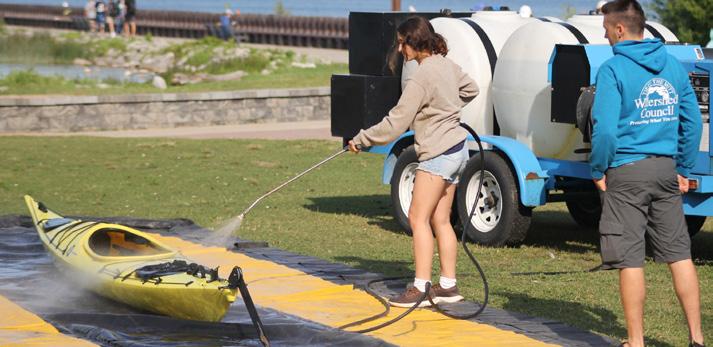
Zebra and quagga mussels are so efficient they can filter one liter of water per day. With the high number of invasive mussels in our waters, they could filter all of Lake Michigan and Lake Huron in less than two weeks.

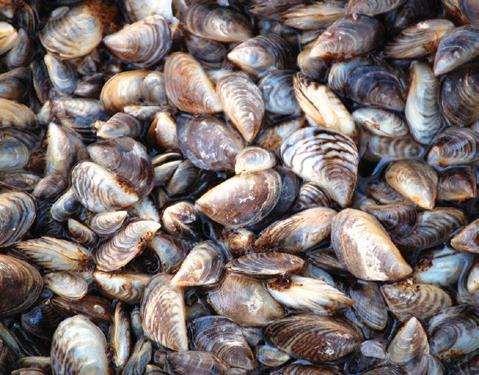
This summer, the Tip of the Mitt Watershed Council deployed two innovative tools— BeBot and PixieDrone—to enhance shoreline cleanups across Northern Michigan. With help from local high school robotics teams including the Paladins from Petoskey High School, these robots tackled pollution both on land and in the water, collecting both harmful debris and critical data.
The BeBot, designed for sand and shoreline areas, targeted microplastics, bottle caps, and other small litter, while PixieDrone operated in nearshore waters, capturing floating waste before it spreads further into lakes. Together, these devices visited 24 beaches throughout the season, including key spots along Little Traverse Bay, gathering hundreds of pounds of trash. Common finds included cigarette butts, plastic fragments, and discarded fishing gear.
The Paladins team played a vital role in programming and operating the robots, troubleshooting technical challenges, and optimizing performance. Their involvement not only kept operations running smoothly but also provided students with real-world experience in environmental science and robotics.
These cleanups did more than just collect litter—they also contributed to pollution monitoring by identifying trends in litter types and quantities. Information that will be shared with our partners a we continue to tackle plastic pollution.
As we continue these efforts, BeBot and PixieDrone will remain essential tools, demonstrating how technology and community partnerships can create sustainable solutions for protecting Michigan’s waters.
It’s not just about washing boats; it’s about fostering a culture of care for our waters. As boaters came through, they didn't just clean their vessels; they learned why it mattered. They heard about the risks posed by these "hitchhiking" invasive species and how their actions could help stop the spread. They left with a better understanding of how to protect the waters they love—and how a small act, like rinsing off a kayak, can have a large-scale impact.
With your support, we can continue to tackle this issue with a mobile and accessible solution—meeting boaters where they are. If you’d like to see MOBO in action next season or join as a volunteer, we’d love to hear from you. Together, we can continue this vital work—boat by boat, lake by lake.
Thank you to our volunteers who poured in their energy and dedication, giving their time to keep this initiative afloat.
In partnership with the US Forest Service and the Department of Natural Resources Michigan Invasive Species Grant Program

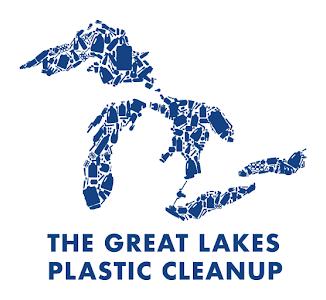



These innovative devices are made available through a partnership with the Great Lakes Plastic Cleanup (GLPC), and are generously funded and supported by North American energy company TC Energy and Midwest retailer Meijer.
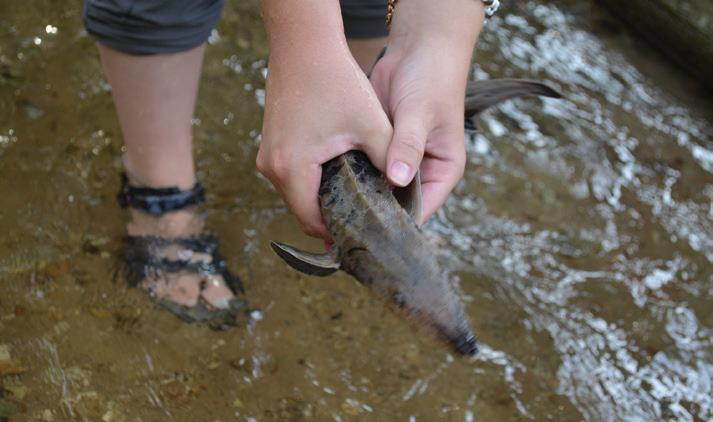

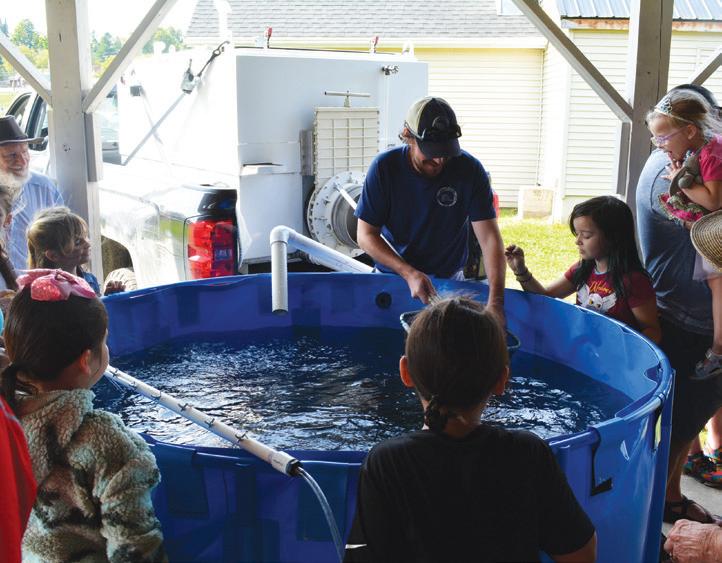
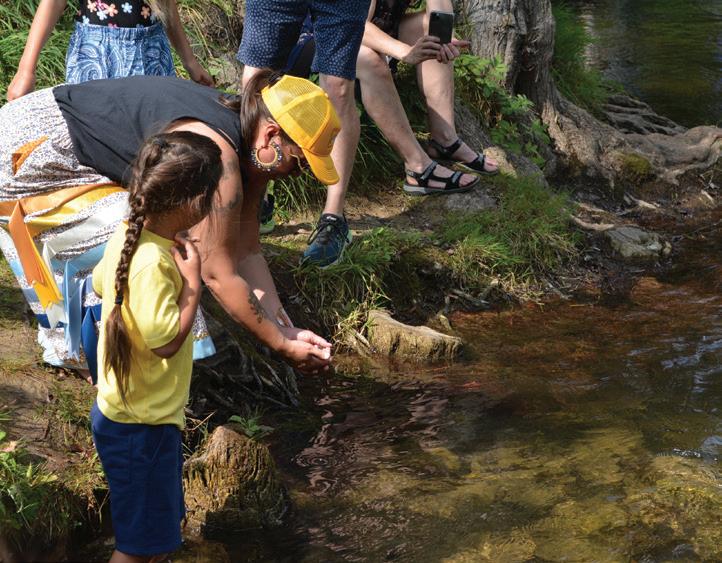
Before the nmé were released, an LTBB Odawa youth read aloud a blessing to honor and guide them on their journey. Nmé, or sturgeon in Anishinaabemowin, hold a special place in Anishinaabek culture, representing the deep connection between the people and the waters. A junior at Petoskey High School, he plans to continue his studies of the Anishinaabemowin language at Bay Mills Community College.
Read and listen to the Anishinaabemowin blessings by scanning the QR code to the right.
On September 14, the banks of the Sturgeon River in Wolverine, Michigan, were alive with anticipation. Dozens of families, conservationists, and curious onlookers gathered at the Sturgeon River Campground for the annual Little Traverse Bay Bands of Odawa Indians Nmé (Sturgeon) Celebration, a communitydriven effort to help restore one of Northern Michigan’s most ancient species: the lake sturgeon.
The atmosphere buzzed with excitement, not just for the rare opportunity to see these prehistoric fish up close, but for the chance to play a direct role in their conservation. In the center of it all, swimming in a portable pool, were hundreds of juvenile sturgeon—each one a testament to the work of the Little Traverse Bay Bands of Odawa Indians (LTBB) Fisheries Enhancement Facility.
The sturgeon touch pool drew a steady stream of fascinated kids and adults alike, eager to run their fingers along the bumpy backs of these tiny but powerful fish. But the true highlight came when participants lined the riverbank, each carefully lowering a sturgeon into the current of the river.
“It’s not every day you get to release a sturgeon,” one parent said with a smile as her child carefully placed a young fish into the river. “It’s exciting to think this little guy might live 100 years—longer than me!”
Among the released fish was Gimiwan, the Watershed Discovery Center’s resident sturgeon, making his journey into the wild alongside his fellow juveniles. Gimiwan resided at the Watershed Council’s Discovery Center this year, made possible through a partnership with the LTBB Fisheries Enhancement Facility.
Since 2013, the LTBB Fisheries Enhancement Facility has released more than 7,000 juvenile sturgeon into the Burt Lake Watershed, with the goal of

reestablishing a self-sustaining population in the region. The fish released this year will spend the next two to three years in the river before migrating to Burt Lake. They won’t reach maturity for another 15 to 20 years, but when they do, they’ll return to the Sturgeon River to spawn, continuing the cycle of life that has persisted for millennia.
Lake sturgeon are a keystone species in Michigan’s freshwater ecosystems. Once thriving, their populations have dwindled over the past century due to habitat loss, pollution, and overfishing. But through restoration efforts and events like the Nmé Celebration, communities are not only helping to restore the sturgeon’s numbers but also reconnecting with the waterways that sustain them.
The partnership between LTBB and the Watershed Council is key to these efforts, blending traditional ecological knowledge with modern conservation and education practices. As Hatchery Manager Kris Dey reminded attendees, the work doesn’t end with this release. Continued habitat restoration and monitoring are crucial to ensuring that the sturgeon will one day thrive again in the region.
As the last of the sturgeon were released into the river, the crowd—and Watershed Council staff—lingered by the water’s edge, watching the tiny fish disappear into the current. It was a hopeful moment—one that looked not just toward the river’s immediate future, but to a time decades from now, when these fish will return to the Sturgeon River to complete their life cycle.
For those who took part, it was a hands-on reminder that conservation is a long game, but one well worth playing.
If you would like to learn more about or support our ongoing education programs and habitat restoration projects, visit watershedcouncil.org or contact Andrea Coronado at (231)489-7272 or acoronado@watershecouncil.org.
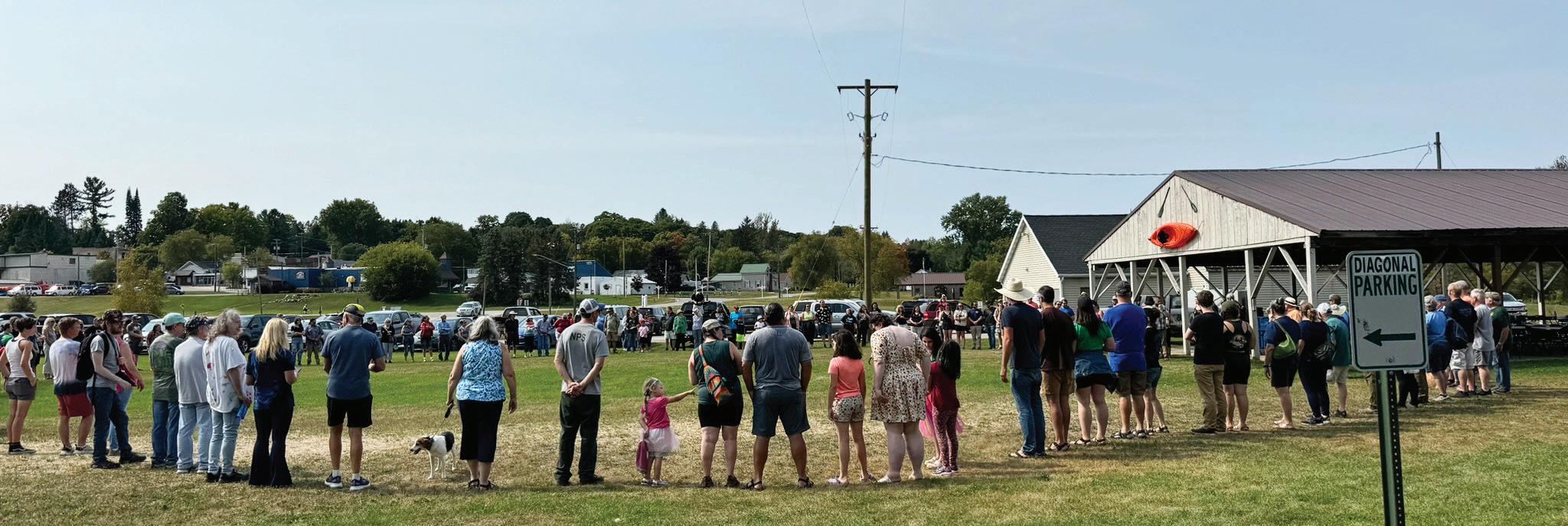
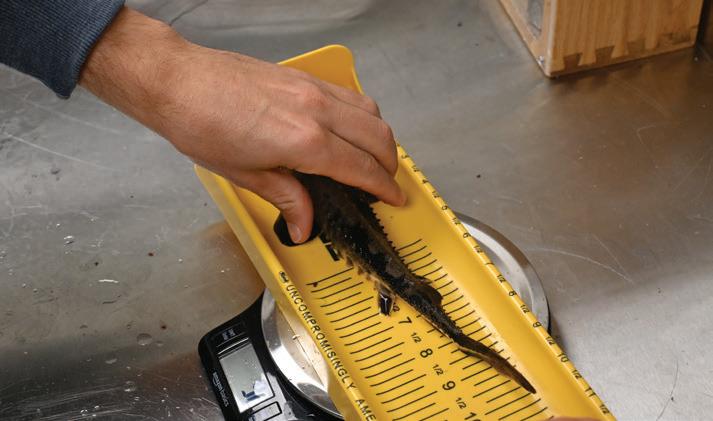
In early June, we welcomed a juvenile sturgeon named Gimiwan to the Watershed Discovery Center. Measuring just 12¼ inches long and weighing 110 grams, Gimiwan was introduced to a tank he shared with a school of whitefish. His diet consisted of an afternoon feeding of bloodworms (midge larvae) and krill, which were stored frozen and thawed for each meal. Over time, it became evident that bloodworms were Gimiwan's clear favorite, and they soon became the main component of his diet.
Gimiwan’s feeding routine was fascinating. As the food settled at the bottom of the tank, he would glide over and use his
four whisker-like sensory organs, called barbels, to detect the meal. With his vacuum-like mouth, he would suck up the food, filtering out the excess sand and substrate, much like he would from a river or lake bed in the wild.
As Gimiwan grew, so did his appetite. Initially, he was provided with around 120 grams of bloodworms per feeding (shared with his tank mates), but by the time of his release, this had increased to 310 grams—a testament to his healthy growth. Every Wednesday, we removed Gimiwan from the tank for measurement, which allowed us to carefully track his development and make adjustments to his diet as needed.
After spending several months under our care, Gimiwan more than doubled in size. By the time of his release into the Sturgeon River in September, he had reached 15¾ inches in length and weighed 234 grams. Now, Gimiwan is out in the wild, foraging along the riverbed for small macroinvertebrates as he continues to grow.
Thanks to generous funding from the Burt Lake Preservation Association, the Watershed Council is expanding its educational offerings at the Watershed Discovery Center. We’re developing guided tours and interactive experiences specifically designed to support local school curriculums. These programs aim to provide hands-on learning opportunities, connect students with their local watershed, and inspire the next generation of environmental stewards. By aligning our educational resources with classroom learning, we are creating meaningful connections between students and the natural environment, helping them better understand the importance of freshwater ecosystems in northern Michigan.
“Our partnership with the Watershed Council reflects our shared commitment to protecting the natural beauty of Burt Lake for future generations. By supporting ongoing education efforts, we hope to inspire a deeper understanding and appreciation of our watershed’s health and resilience.”
JIM BURKE

For years, Burt Lake Preservation Association has proudly supported the repopulation of lake sturgeon, a keystone species in Michigan’s waterways. This commitment began with a vision to restore balance to Burt Lake’s ecosystem by helping rebuild the sturgeon population, which has dwindled over the last century due to habitat loss and overfishing. Partnering with local biologists and conservation groups, the Association has funded and participated in hatchery projects, fish releases, and habitat improvement initiatives, all aimed at giving young sturgeon a fighting chance to thrive. Thanks to these efforts, sturgeon are slowly returning to Burt Lake—a testament to the impact of dedicated stewardship.
Though Gimiwan may be small now, he has an exciting future ahead of him. Lake sturgeon like Gimiwan can grow to over 7 feet long and live for more than 100 years. We are hopeful for his journey ahead and look forward to the possibility of seeing him grow into one of the giants of the river.
Hi, I'm Winnie!
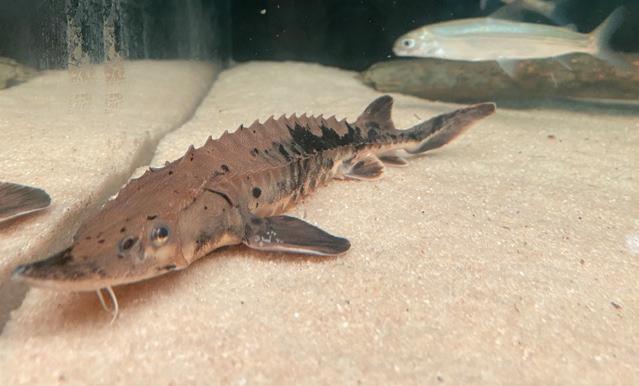
Meet “Winnie,” the newest resident at the Watershed Discovery Center! Winnie weighs 52.5 grams and measures 9 inches. We will be charting her growth and studying her behaviors over the next year before her release next September.
The Watershed Discovery Center is a place of learning, exploration, and connection with our local waters. But to keep it thriving, we need your help!
Your support can help feed the sturgeon, arctic grayling, and whitefish at the Discovery Center, maintain their habitats, and expand our educational programs for local schools. Every donation, no matter the size, ensures we can continue offering hands-on experiences that inspire young minds and foster a love for our freshwater ecosystems. Together, let’s protect our waters and inspire the next generation— your gift can make it happen. Use the enclosed envelope to send your support, or donate using the QR code to the left.


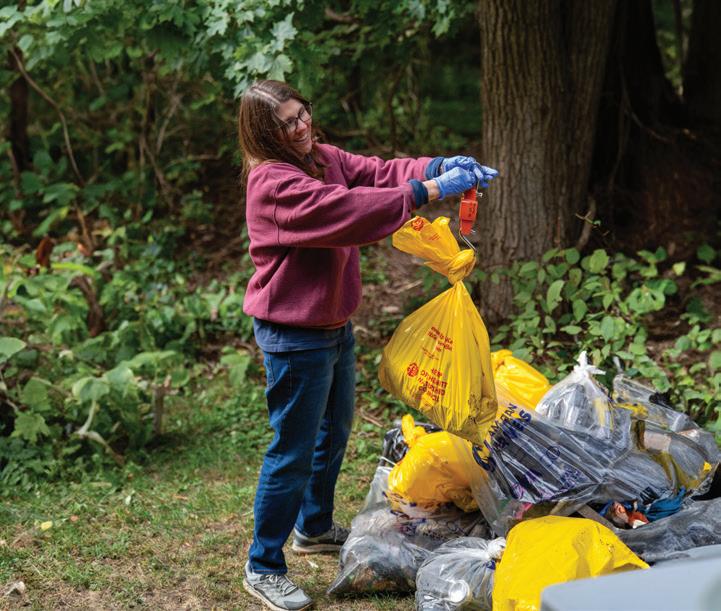
Green spaces, parks, and public water resources are crucial for the quality of life in Petoskey. At the heart of our city’s park system is the Bear River Valley Recreation Area, spanning 36 acres of beautiful public space with the Bear River at its core.
This river, running swiftly along forested banks, is home to diverse fish and wildlife. But it wasn't always this way. The Bear River suffered for decades from industrial use and dumping, serving as a working river that provided timber and hydropower to Petoskey. Logs from upstream clear-cut forests were floated down to mills, leaving the riverbed choked with sand from eroding banks. Dams generated power for sawmills, gristmills, and electric lines, disrupting the river's flow and aquatic life. At times, the river was even a dumping ground for waste.
In 2000, the Tip of the Mitt Watershed Council and numerous community partners launched the “Healing the Bear” Bear River Cleanup to tackle the river's historical degradation and protect its future. Over the years, we've pulled out spools of barbed wire, countless tires, and rusty metal pieces. Today, the Bear River is part of our ongoing efforts like erosion control, stormwater management, invasive species control, and trash clean-up events. Thanks to the dedication of Petoskey and Village of Walloon Lake communities, the
Bear River is healthier today than it has been in decades.
This year’s “Healing the Bear” Bear River Cleanup, in partnership with Bearcub Outfitters, continued this legacy of protection and preservation. The event brought together nearly 100 volunteers who collectively removed 650 pounds of trash from the river and surrounding areas.
The cleanup covered 15 miles of the river and multiple road stream crossings. Natural debris was left untouched, while recyclables, electronics, tires, and scrap metal, were collected, cataloged, and properly disposed of at the Emmet County Transfer Station.
A big thank you to our event partner Bearcub Outfitters, and sponsors American Rivers, City of Petoskey, Emmet County Recycling, Grain Train Natural Foods Market, Jo Jo’s Cookies, Meijer, Oleson’s Food Stores, Petoskey Plastics, Roast & Toast, and Walmart.
Our ongoing restoration efforts are funded by the generosity of our members and donors. To learn more about how you can help expand our restoration programming, contact Andrea Coronado at acoronado@watershedcouncil.org or (231) 489-7272.
Scan the QR code to take an aerial tour of the Bear River
“At Bearcub Outfitters, we believe in taking care of the places that give so much to our community, and the Bear River is one of those special places. Sponsoring the ‘Healing the Bear’ cleanup is our way of giving back, ensuring that future generations can enjoy the beauty and recreation the river offers. It’s incredible to see how much can be accomplished when the community comes together for a cause like this.”
BECKY PHILIPP-KRANIG


Balancing road safety with the health of our freshwater systems is a delicate task. Chloride contamination—from road salt, brine, and even landscape runoff—poses a growing threat to our lakes, rivers, and streams. While chloride is a naturally occurring element vital for aquatic life, excessive concentrations can be harmful. High chloride levels can become toxic to wildlife, compromise drinking water, disrupt ecosystems, and contribute to soil erosion. To address this pressing issue in northern Michigan, the Mullett Area Preservation Society (MAPS) has teamed up with the Watershed Council on a Chloride Monitoring Project.
The MAPS Chloride Monitoring Project, conducted between fall 2023 and summer 2024, involved sampling ten sites: nine along the Indian River and one on Mullett Creek. Chloride levels were measured using Hach® Chloride Test Strips, capable of detecting concentrations between 30 and 620 parts per million (ppm). Of the ten sites, seven showed chloride concentrations above 30 ppm. Three of the sites had chloride concentrations higher than the typical ambient levels for the Mullett Lake/Cheboygan River Watershed, with the highest value recorded at 83 ppm. Historically, chloride levels in the Indian River have not exceeded 12.5 ppm, making these readings a cause for concern.
More alarming were the results from two specific sites where chloride concentrations approached or exceeded Michigan's maximum aquatic safety threshold of 320 ppm, with levels reaching as high as 620 ppm.
Several factors could explain these elevated chloride levels, including precipitation, seasonal activities, and site-specific conditions. For example, samples were collected within 24 hours of a rain event, suggesting that stormwater runoff may have contributed to the high readings. The highest chloride levels were observed during winter and spring sampling events—when road salt usage is at its peak, and coinciding with the application of brining solutions in Tuscarora Township. These seasonal road safety measures may be a direct cause of the elevated chloride levels. Additionally, the sites with the highest readings were located near direct drainage areas and stormwater confluence points, making
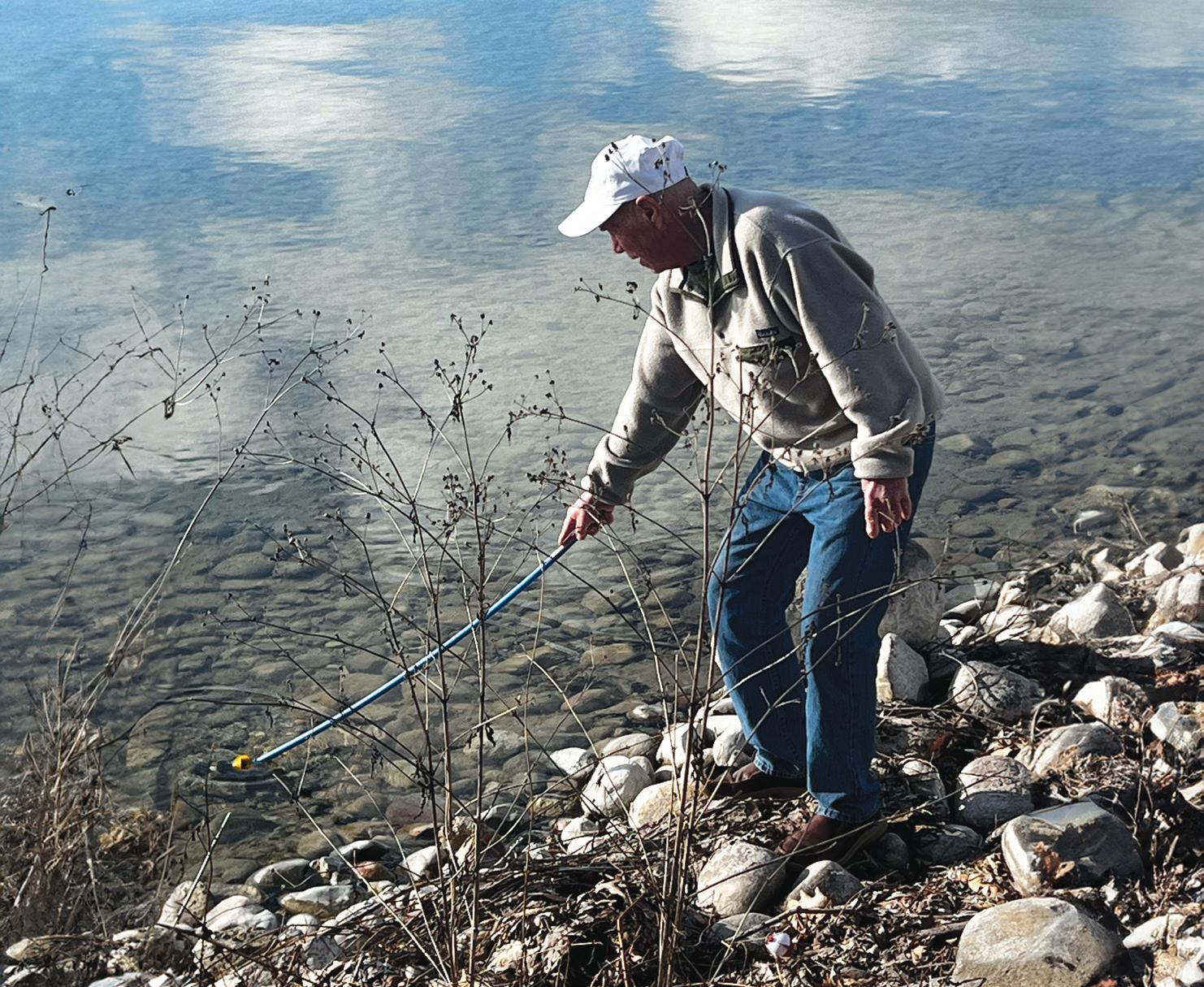
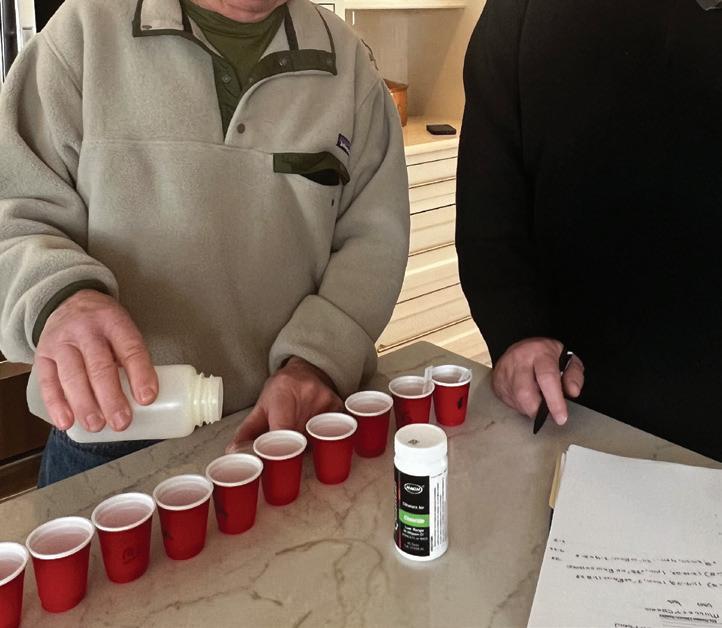
them particularly vulnerable to chloride contamination from runoff.
Based on these findings, the Watershed Council and MAPS plan to take further action. Potential next steps include more extensive sampling, exploring bioengineering techniques to mitigate runoff, and organizing educational workshops to raise awareness about the impacts of excess chloride. This pilot project has provided crucial insights into chloride pollution in northern Michigan’s waters, and continued research will undoubtedly deepen our understanding and help protect our freshwater resources.

In partnership with Mullett Lake Area Preservation Society
Want to learn more about our contract services for your lake? Contact Marcella Domka, Water Resources Manager, at (231) 489-7271 or mdomka@watershedcouncil.org.
Scan the QR code to watch our recent Ice Breaker Lecture on Road Salt

